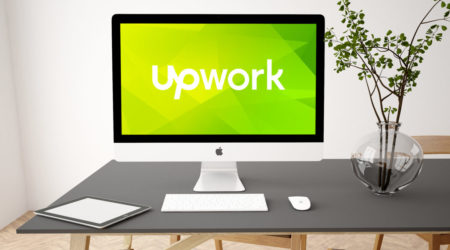Creating a financially secure life can feel daunting at the best of times, but it can feel nearly impossible for freelancers. Budgeting for freelancers can feel like navigating an uncharted wilderness without a GPS. You’re probably going to get lost and eaten by bears.
Except the bear, in this case, is the IRS, which also stands for “I’m Running Scared” from bears.
All jokes aside, your financial goals, budget, and savings are very important for a budding freelancer. You need to plan for today, so you can figure out the direction you’re heading.
👋 Psst...Have you seen the all-new Feedcoyote yet? They've got a new look, more freelance opportunities, and the best collaboration tool for freelancers! Join over 100,000 fellow freelancers who network, find clients, and grow their business with Feedcoyote. Join for Free »
Preparing in advance has its positives. 92% of Americans say that “nothing makes them happier or more confident than when their finances are in order.” You can be one of those American’s if you follow our comprehensive budgeting for freelancers guide. Let’s get started.
7 Freelance Budgeting Hacks:
When it comes to budgeting, it’s better to cannonball into the pool than dip your toe in. Let’s begin your finance journey by brainstorming your short and long-term business goals.
1. Set short-term and long-term goals
Building financial security is an ongoing juggling act. Whether you can accomplish your goals now or later doesn’t matter; you have to keep your balls in the air at all times.
At the same time, you need to consider if it’s better to change your short-term goal into a long-term one. For example, it’s entirely possible to turn your freelancing solo career into a full-fledged agency on a shoe-string budget, but it would be easier to build up some capital first.
Keep your goals list next to your financial program or documents. That way, you’ll always be reminded of exactly what you’re budgeting towards. To set your expectations, ask yourself:
- Do I want to invest more in my business?
- Am I saving for a rainy day?
- Can I save enough in a year to buy an office?
- How much of my income do I want to put towards family planning?
As a rule, keep your short-term goals to daily, weekly, or monthly achievements. A short-term monthly goal can range from 1-3 months. A long-term goal can be anything beyond that.
2. Use invoices and software to track earned income
Whether you’re an analog accountant or a QuickBooks aficionado, you need to track earned income. The easiest way to do this is by making electronic invoices with accounting software.
Why? For several reasons:

- You’re freelancing from your computer anyway, so why switch to analog?
- You’re likely filing your taxes electronically, and you need invoices as proof of income.
- You need to check your bank balance through your computer or phone.
- It’s faster to input your financial information in software that populates everywhere, from your mobile phone to your payroll to your clients and finally, to the taxman.
If you ever plan to scale your freelance business, it’s vital to get into the habit of tracking your income and filling out invoices. Once you become a business entity, you absolutely need invoices to prove your income to the IRS. There’s no ifs, ands, or buts about it.
To set up your invoices with budgeting in mind, use a freelance invoice app. Seriously, any of the ones featured on our list will do, but we’ll focus on our top pick, Moxie, for a few reasons.
Hectic is an all-in-one client and project management software that comes with a calendar, accounting functionality, and the ability to make invoices, contracts, and proposals. What makes Hectic budget-friendly is its ability to calculate lifetime earnings across your projects. You can read an in-depth review on Hectic here.
Since most freelancers don’t have a steady paycheck, especially when they start, calculating your total lifetime earnings can help make budgeting less of a rollercoaster ride.
3. Make sure your method includes multiple income sources
Although some freelancers will stick to one gig, several others will compile multiple incomes or passive income streams to make ends meet. For this reason, your budgeting method must include several income streams, or you may forget to add them to your taxes.
If a freelancer is selling digital products and does a bit of dropshipping on the side, it won’t be easy to keep these two businesses separate. It becomes even more complicated if you’re dealing with different currencies. Financial software just makes this whole scenario simpler.
Freelancers who don’t have multiple income streams will still benefit from setting up their infrastructure early, especially if your long-term financial goals include saving.
Even with software, it’s still possible to mix up your personal and business purchases.
4. Open a separate account for your business

You absolutely have to do this if you make a significant amount of money from your freelance income. Remember that budgeting for freelancers includes saving money for taxes (more on that later). If you have a separate self-employed bank account, you can easily budget and plan for tax season.
Some freelancers will set up a different e-wallet where clients will deposit payments. This option is great for new freelancers, but as you scale, this option may become expensive or bulky. E-wallets often charge a fee per invoice, so it’s better to open a separate checking account.
5. Start setting your freelancer salary expectations
We know freelancers can’t always control how much they’ll be paid per month, but they have complete control over their contract terms. Being able to properly save starts before your client signs the contract, so set deadlines for when they need to pay you and charge late fees.

While it may sound harsh to charge interest on a late payment, think of it from another perspective. Every day you’re not paid is another day your bills inch closer to being overdue.
What happens when your bills are overdue? You’re charged interest. Why? To encourage you to pay.
To budget effectively, you also need to encourage your clients to pay.
However, you can’t start charging interest after your client signs the contract because there’s no incentive to pay it. Make a point of explaining incurring interest fees to your clients. Once they see that you’re serious about getting paid on time, you’ll reduce late payments once and for all.
6. Calculate your fixed expenses
You’ll always have to pay your rent and utilities, but your fixed expenses are unique to you. If you consistently spend the same on groceries, insurance, debt, and dry cleaning, you can account for how much money you’ll have left for savings, business growth, and entertainment.
What you do as a freelancer will also determine other fixed expenses. A freelance writer may have to pay a subscription to Grammarly monthly, while a graphic artist has to fork over money for Photoshop. Required business expenses also must be included in the “fixed” category.
7. Think and plan in three-month increments
If you’ve been a freelancer for less than a year, it will be harder to look at a yearly snapshot of your expenses. Whether you’re a newbie or a veteran, it’s a good idea to plan your budget in three-month increments. There are a few reasons for doing this:
- Once you make enough money, the IRS will expect you to pay your taxes quarterly.
- You’ll have a more accurate indication of your average earnings.
- You can see where your “famine” months are and plan accordingly.
Let’s say your 3-month average is $3000 per month. That means you’ll approximately make $9000 every three months and $36,000 per year. Since 25-30% should go towards your taxes, that means you’re left with $25,200 for your budget, or $2,100 per month of usable income.
Presuming that 20% goes towards saving, you’ll need to live off 50% of your paycheck, so $1,500. Keep in mind that this number isn’t static; you can adjust your budget as you go.
It’s a good idea to make a “dream budget” first and adjust if you’re way off. Once you create a budget, you need to watch it closely. Otherwise, you could find yourself in a lot of debt.
Don’t forget about freelance taxes
Learning how to do taxes as a freelancer is one of the most difficult steps to becoming independent. In the previous section, we touched upon how 25-30% of your income should be saved for taxes. This is important because your revenue will come to you “tax-free.”
How to save for self-employment taxes
At the end of the year, you’ll need to pay off your tax burden to the IRS if you make more than $400 in self-employment income. If you make less than $400, you’ll still need to claim it.
The self-employment tax rate is 15.3%: 12.4% for Social Security and 2.9% for Medicare. An additional 0.9% is added once you reach beyond a threshold amount.

If your tax burden is more than $1000 at the end of each quarter, you’ll need to submit quarterly returns. If you’re unsure if your business meets these requirements, use an estimated self-employment tax calculator. Knowing this information in advance will save you from audits.
While 25-30% sounds like a lot of money to save, this percentage is just an estimate. It’s better to save more than less if you’re short one month and can’t contribute to your taxes.
Our top tool to help you with these tasks is Bonsai. It allows you to track 1099 expenses & keep peace of mind at tax time.
Bonsai was built exclusively for self-employed workers to track expenses, maximize tax write-offs, and estimate quarterly taxes.
Freelance deductions
One of the best parts about budgeting for freelancers involves the many ways you can save money. Freelancers can deduct the following from their taxes:
- Home office expenses
- Internet and phone bills
- Health insurance premiums
- Business meals and travel
- Vehicle use
- Loan and credit card interest
- Publications and subscriptions
- Education
- Business insurance
- Rent (from office space)
- Startup costs
- Advertising
- Retirement plan contributions
If you keep all of your receipts and itemize your transactions, you’ll be able to take advantage of your deductions and save even more money. You can use your tax “refund” for anything, but it’s recommended that you put the money back into your business or your savings.
Budgeting for freelancers & saving at the same time
When making a budget, it’s essential to consider the amount you’ll put towards savings. Ideally, 20% of your income will go towards preparing for your personal and professional future. We’ll break this concept down into different “cushions” or “pots” that you should pay into.
Rainy-day fund
Set up a separate savings account where you can throw $10-$100 dollars in each month. This account should be easily accessible. Your rainy day fund is meant for smaller expenses, like paying for a flat tire, fixing a broken window, or other unexpected, short-term costs.
Emergency fund
Your emergency fund is for financial emergencies, including job loss, major illnesses, or injury. Aim for an emergency fund of at least three to six months of living expenses, including debt payments, everyday spending (groceries), and rent/utility bills.
Health and dentistry fund (tax-deductible)
You’ll need to put some money into your health, dental, and qualified long-term care insurance if you aren’t eligible to participate in your spouse’s plan. If you do pay this cost, you’ll be able to deduct your health insurance as well as your spouse’s and your dependent’s premiums.
Retirement fund (tax deductible)
Budgeting for freelancers includes saving for retirement because you won’t have an employer who sets up an IRA or 401(k) for you. You also won’t have an employer that matches your contribution. However, anything you contribute to your plan lowers your tax burden.
Freelancers typically opt for the SEP-IRA, SIMPLE, and solo 401(k), but you can also pay into a pension or guaranteed income annuities. For now, stick to an IRA and/or 401(k) because they’re the easiest to manage. You may want to open a high-interest savings account to save more.
Investment fund
At some point, you may be interested in investing in stocks, bonds, and mutual funds. However, you have to make sure you know what you’re doing. If you want to invest in the market yourself, search for quality data-driven stock research websites that cater to beginner investors.
On the other hand, you could hire an investment broker if you have some spare change. Either way, you can build your investment portfolio to help save for your retirement. Fill your portfolio up with government bonds and low-cost stocks specifically for long-term investing.
Business insurance fund (tax-deductible)
It’s important to set aside money to protect your physical business (home or otherwise) from natural disasters or theft, but you may also need car, credit, and business liability insurance. Most business insurance is tax-deductible, which eases the upfront cost of business protection.
Business costs fund (tax-deductible)
Keeping a “rainy-day fund” specifically for your business can help you replace items like computers, software, or printers if something goes wrong. The business costs fund should not include any fixed costs unless you’re investing in education to improve on your credentials.
Business expansion fund
As you start to expand your client base, you can add more money to this fund. Budgeting for freelancers can get complicated if you’re only focused on expansion. In the beginning, it’s a good idea to approach growth slowly and invest here when you have a bit of money left over.
Why budgeting for freelancers is important

There’s a comfort in a fixed salary. You’ll know exactly what you’ll make every two weeks, making budgeting a breeze. If you know your fixed expenses equal X and your guaranteed income equals more than X, then you’re guaranteed to never fall short. In theory.
Why fixed income earners come up short
But having a fixed income doesn’t necessarily make you a better budgeter, saver, or investor. In fact, it may backfire in some cases, especially if you have more money to spend.
60% of millennials making over $100,000 a year live paycheck to paycheck. This suggests that salary has very little to do with how much money you’ll take home at the end of the week. It’s clear to see that having a competent budget is the key to building long-lasting wealth.
How a variable income can actually be helpful
Whereas someone who makes a fixed salary can brush themselves off and start saving, freelancers don’t always have that option. One lean month could put them in severe debt.
When you truly don’t know what you’ll make from month to month, you’re more compelled to make a budget just to be safe. On the other hand, fixed salary earners tend to take that for granted. Living like you have a variable income is the best way to prepare for the worst.
What’s more, a variable income can help you prepare for the best. If you want to scale, a budget can help you keep some money aside for expansion, meaning you’ll have fewer lean months.
Freelancers must budget for a level they can reach
Salary earners often operate with a false sense of security, but freelancers are aware that their position isn’t secure. The last thing they want to do is budget at a level they’ll struggle to reach.
A higher paying job should lead to more money in the bank, not to more stuff. Therefore, a freelancer’s “cushion” comes from various pots of money, such as a travel fund, rainy day fund, emergency fund, and anything else. Anything leftover can then be used for fun or expansion.
As entrepreneurs start to earn a more stable income, budgeting for freelancers includes filling in those cushions. Otherwise, you may have to give up your freelancing gig for employment.
Budgeting is easy, struggling is hard
Creating a budget can be a pain, but do you know what’s way worse than that? Struggling between paychecks. At the same time, it’s hard to see the light at the end of the tunnel.
While it’s true that budgeting will take up a lot of upfront time, that’s just because you haven’t developed “financial tracking” as a habit. Budgeting for freelancers becomes second nature with a bit of practice; you just need to use the right tools and follow the right guide.
But you’re already at the right guide; now it’s time for you to do the rest. Still, we’re here to help. There are plenty of guides on Millo that focus on getting your freelancing career up and running, so it can start on the right foot. Then, you’ll be in a great position to scale.
Keep the conversation going...
Over 10,000 of us are having daily conversations over in our free Facebook group and we'd love to see you there. Join us!




